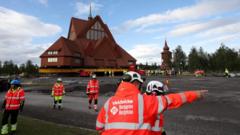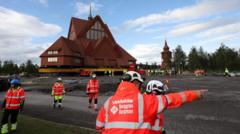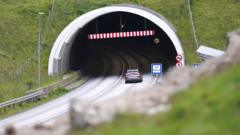As the 113-year-old Kiruna Church is carefully relocated to evade ground subsidence due to mining activities, it embodies a significant emotional and cultural transition for residents. Supported by modern engineering, the church's move illustrates both the challenges and triumphs faced by communities reliant on natural resources.
Historic Church Relocation Marks New Chapter for Kiruna Residents

Historic Church Relocation Marks New Chapter for Kiruna Residents
The iconic Kiruna Church embarks on a two-day journey to its new home, symbolizing the community's resilience amid environmental changes.
A major transformation is underway in Kiruna, Sweden, as a cherished 113-year-old church is being relocated to protect it from ground subsidence associated with extensive iron ore mining in the region. The iconic red timber structure, which has stood since 1912, is being carefully transported over a distance of 5km (3 miles) along specially prepared roads.
This ambitious operation began with the church being hoisted onto giant rolling platforms, allowing it to proceed at a measured pace of up to 500m per hour. Project manager Stefan Holmblad Johansson expressed both pride and responsibility, affirming that the meticulous planning behind this monumental task is crucial, with every detail being accounted for to ensure the church's safe transport.
Kiruna, located 145km north of the Arctic Circle, has faced the impact of mining activities that have led to the destabilization of its land. The church's journey represents a pivotal moment in the broader relocation of buildings around the city, including landmarks that were either demolished or moved intact over the past decade. Notably, structures like the old city hall's clock tower have undergone similar relocations.
Under Swedish regulations, mining can no longer occur beneath occupied buildings, prompting this unprecedented move. Local officials, including Robert Ylitalo, CEO of Kiruna's development company, explained the necessity of relocating infrastructure to prevent future hazards. As part of the move, LKAB, the operator of the iron ore mine and the largest employer in Kiruna, is financing the overall relocation costs, estimated at over 10 billion Swedish kronor (roughly $1 billion).
Engineering challenges have been addressed with ingenuity, including road expansions to accommodate the church’s width and considerations for the church’s interior treasures. Notably, an elaborate altar painting by Prince Eugen will remain safely secured within the church during transport, showcasing the protective measures taken to preserve its historical significance.
For many residents, the relocation holds profound emotional weight. Sofia Lagerlöf Määttä, a culture strategist, shared her childhood memories linked to the church, emphasizing its role as a communal gathering place. Vicar Lena Tjärnberg echoed these sentiments, acknowledging both the necessity of the move and the nostalgia it carries as the church departs its original foundations.
As the monumental walls of the Kiruna Church inch forward, thousands of community members—together with dignitaries, including Sweden’s King Carl Gustaf—are anticipated to witness this extraordinary event. The journey is being broadcast live, illustrating a rare occasion where history not only survives change but thrives alongside it.





















